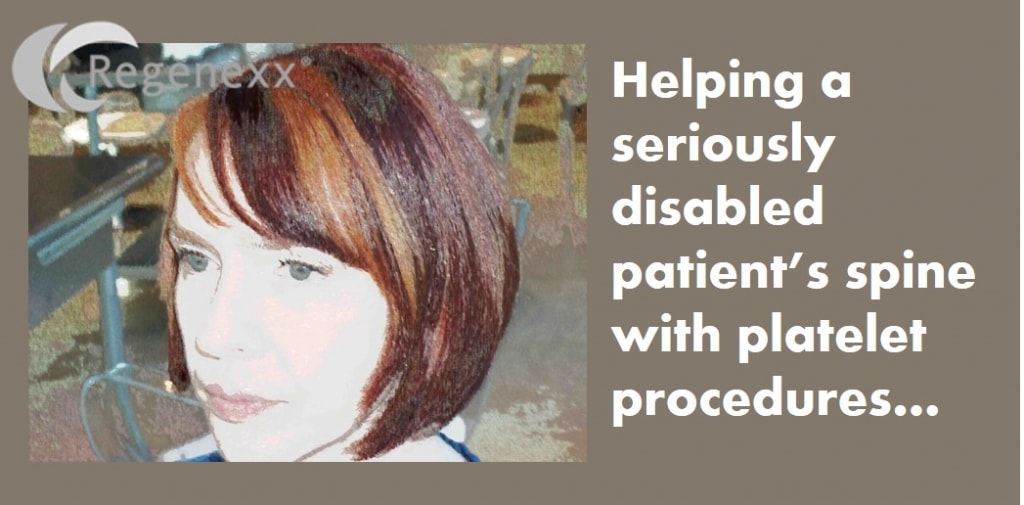Stem Cells for Back Pain? One Patient’s Experience…
Stem cells for back pain have been a big topic this past year or so. This is Claire’s story, who I think like many, believed that a stem cell injection in her spine could help her disability. When I first saw her MRI and heard her story though I was a bit daunted, I knew that she would need a broad array of regenerative technologies deployed in specific areas to give her the best chance of success and that likely didn’t include stem cells out of the gate. So we focused our efforts on using various advanced preparations of her own blood platelets and platelet growth factors injected precisely around specific nerves and into specific joints and ligaments. Here’s her story in her words after her first round of injections:
“I was badly injured in a car accident over two decades ago. Although I suffered occasional periods of prolonged incapacitation, I was always able to resume living an active life without surgeries or narcotic drug dependencies.
Fast forward to my mid-forties: I was back in peak shape, working out strenuously again. I was doing eight to ten miles on an incline trainer four to six days a week; I did Bar Method or Total Gym work-outs on the other days. One day, it felt as if a wall of pain just hit me; it began with severe pain radiating down both legs, making it impossible for me to remain in a seated position for more than five minutes. I couldn’t lie on my back for more than twenty minutes without my lower back going into involuntary spasms; thus, sleep was elusive even with high dosages of sleeping medication. Trying to hold still for an MRI while on my back was almost impossible; I had to take heavy doses of pain pills and muscle relaxers to lie still long enough to complete the imaging without shaking uncontrollably.
My knees began to buckle, which resulted in countless falls, one of which broke my right (dominant) wrist. Eventually, I had absolutely no comfortable position left. I couldn’t sit, stand, walk, or lie on my back or sides; I had to constantly change from one excruciatingly painful position to another. Walking became increasingly difficult and I had to use a wheelchair, which was emotionally devastating. I became a disabled “shut in” who was dependent upon others for almost everything for over two years. I felt my life was over; I seriously contemplated suicide on a number of occasions.
Updated MRIs revealed that rapid deterioration of my spine and knee injuries had occurred with age. My diagnoses include multiple herniated, bulging, and degenerated discs at almost every level of my spine and pinched nerves between these discs. The lumbar spine is the most severely degenerated: L-3, L-4, and L-5 are virtually rubbing “bone on bone.” I am also diagnosed with spinal stenosis, scoliosis, DDD, and secondary osteoarthritis of the spine. Both knees are diagnosed as subluxated, with torn menisci, secondary osteoarthritis, and a cyst in the left knee. I am also diagnosed with tendinosis of the right tendon and told I have a “repetitive stress injury” in my left elbow.
My neurosurgeon recommends fusion of a number of the discs and the installation of a narcotic pain pump in my back. My knee specialist recommends arthroscopy of both knees along with some additional procedures. I am prescribed a cocktail of pain pills and muscle relaxers that I seldom take. Taking only one of these substances makes me a zombie and I have horrible side effects from the meds.
Having extensively researched the use of bone marrow derived, autolgous stem cells to treat orthopedic injuries, I decline all traditional, invasive orthopedic surgeries and tell my doctors of my plans to seek treatment from Dr. Centeno; my GP, the neurosurgeon and the orthopedic surgeon scoffed at my treatment plans. Fortunately, I have three other physicians, including one educated at Oxford, who fully supported my choice of treatment and choice of physician, in lieu of traditional, invasive orthopedic surgeries.
Dr. Centeno treated my lumbar spine twice; he also treated both of my knees, my cervical spine, right tendon, and left elbow. After years of forced inactivity, I’m now able to resume my home-based physical therapy, followed by walking two miles at two mph on a treadmill on an almost daily basis. The left elbow pain seems to be gone, as does the tendinosis. The pain in my legs and knees is less severe now. If I had followed the orders to have the traditional procedures and taken all those narcotics, I would likely still be confined to a wheelchair, facing a life of endless surgeries and narcotic drug dependencies.
I still have a long way to go in my recovery, but this is infinitely preferable to being stuck in a wheelchair for life, having repeated surgeries, and being dependent upon a cocktail of nasty narcotics!”
So while she may need at some point to have stem cells injected into her disc, I’m encouraged that a broader treatment approach is helping get her back to being active again!

If you have questions or comments about this blog post, please email us at [email protected]
NOTE: This blog post provides general information to help the reader better understand regenerative medicine, musculoskeletal health, and related subjects. All content provided in this blog, website, or any linked materials, including text, graphics, images, patient profiles, outcomes, and information, are not intended and should not be considered or used as a substitute for medical advice, diagnosis, or treatment. Please always consult with a professional and certified healthcare provider to discuss if a treatment is right for you.
